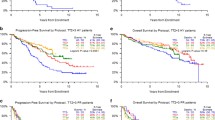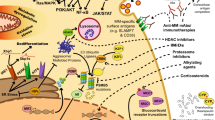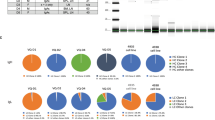Abstract
Despite improvement in therapeutic efficacy, multiple myeloma (MM) remains incurable with a median survival of approximately 10 years. Gene expression profiling (GEP) can be used to elucidate the molecular basis for resistance to chemotherapy through global assessment of molecular alterations that exist at diagnosis, after therapeutic treatment and that evolve during tumor progression. Unique GEP signatures associated with recurrent chromosomal translocations and ploidy changes have defined molecular classes with differing clinical features and outcomes. When compared to other stratification systems, the GEP70 test remained a significant predictor of outcome, reduced the number of patients classified with a poor prognosis, and identified patients at increased risk of relapse despite their standard clinicopathologic and genetic findings. GEP studies of serial samples showed that risk increases over time, with relapsed disease showing GEP shifts toward a signature of poor outcomes. GEP signatures of myeloma cells after therapy were prognostic for event-free and overall survival and thus may be used to identify novel strategies for overcoming drug resistance. This chapter will focus on the use of GEP of MM to define high-risk myeloma and elucidate underlying mechanisms that are beginning to change clinical decision-making and inform drug design.
Access this chapter
Tax calculation will be finalised at checkout
Purchases are for personal use only
Similar content being viewed by others
References
Agnelli L, Mosca L, Fabris S et al (2009) A SNP microarray and FISH-based procedure to detect allelic imbalances in multiple myeloma: An integrated genomics approach reveals a wide gene dosage effect. Genes Chromosomes Cancer 48:603–614
Alizadeh AA, Eisen MB, Davis RE et al (2000) Distinct types of diffuse large B-cell lymphoma identified by gene expression profiling. Nat 403:503–511
Anderson KC (2007) Targeted therapy of multiple myeloma based upon tumor-microenvironmental interactions. Exp Hematol 35:155–162
Anderson KC (2011) Oncogenomics to target myeloma in the bone marrow microenvironment. Clin Cancer Res 17:1225–1233
Anguiano A, Tuchman SA, Acharya C et al (2009) Gene expression profiles of tumor biology provide a novel approach to prognosis and may guide the selection of therapeutic targets in multiple myeloma. JCO 27:4197–4203
Avet-Loiseau H, Attal M, Moreau P et al (2007) Genetic abnormalities and survival in multiple myeloma: the experience of the Intergroupe Francophone du Myelome. Blood 109:3489–3495
Avet-Loiseau H, Leleu X, Roussel M et al (2010) Bortezomib plus dexamethasone induction improves outcome of patients with t(4;14) myeloma but not outcome of patients with del(17p). J Clin Oncol 28:4630–4634
Barlogie B, Zangari M, Bolejack V et al (2006a) Superior 12-year survival after at least 4-year continuous remission with tandem transplantations for multiple myeloma. Clin Lymphoma Myeloma 6:469–474
Barlogie B, Tricot G, Anaissie E et al (2006b) Thalidomide and hematopoietic-cell transplantation for multiple myeloma. N Engl J Med 354:1021–1030
Barlogie B, Tricot G, Haessler J et al (2008) Cytogenetically defined myelodysplasia after melphalan-based autotransplantation for multiple myeloma linked to poor hematopoietic stem-cell mobilization: the Arkansas experience in more than 3,000 patients treated since 1989. Blood 111:94–100
Bartel TB, Haessler J, Brown TL et al (2009) F18-fluorodeoxyglucose positron emission tomography in the context of other imaging techniques and prognostic factors in multiple myeloma. Blood 114:2068–2076
Bergsagel PL, Kuehl WM (2005) Molecular pathogenesis and a consequent classification of multiple myeloma. J Clin Oncol 23:6333–6338
Bergsagel PL, Kuehl WM, Zhan F et al (2005) Cyclin D dysregulation: an early and unifying pathogenic event in multiple myeloma. Blood 106:296–303
Brito JL, Walker B, Jenner M et al (2009) MMSET deregulation affects cell cycle progression and adhesion regulons in t(4;14) myeloma plasma cells. Haematologica 94:78–86
Broyl A, Hose D, Lokhorst H et al (2010) Gene expression profiling for molecular classification of multiple myeloma in newly diagnosed patients. Blood 116:2543–2553
Burington B, Barlogie B, Zhan F et al (2008) Tumor cell gene expression changes following short-term in vivo exposure to single agent chemotherapeutics are related to survival in multiple myeloma. Clin Cancer Res 14:4821–4829
Carew JS, Nawrocki ST, Krupnik YV et al (2006) Targeting endoplasmic reticulum protein transport: a novel strategy to kill malignant B cells and overcome fludarabine resistance in CLL. Blood 107:222–231
Carrasco DR, Tonon G, Huang Y et al (2006) High-resolution genomic profiles define distinct clinico-pathogenetic subgroups of multiple myeloma patients. Cancer Cell 9:313–325
Chapman MA, Lawrence MS, Keats JJ et al (2011) Initial genome sequencing and analysis of multiple myeloma. Nat 471:467–472
Chauhan D, Auclair D, Robinson EK et al (2002) Identification of genes regulated by dexamethasone in multiple myeloma cells using oligonucleotide arrays. Oncogene 21:1346–1358
Chauhan D, Li G, Auclair D et al (2003) Identification of genes regulated by 2-methoxyestradiol (2ME2) in multiple myeloma cells using oligonucleotide arrays. Blood 101:3606–3614
Chesi M, Bergsagel PL, Brents LA et al (1996) Dysregulation of cyclin D1 by translocation into an IgH gamma switch region in two multiple myeloma cell lines. Blood 88:674–681
Chesi M, Nardini E, Lim RS et al (1998) The t(4;14) translocation in myeloma dysregulates both FGFR3 and a novel gene, MMSET, resulting in IgH/MMSET hybrid transcripts. Blood 92:3025–3034
Chng WJ, Kuehl WM, Bergsagel PL et al (2008) Translocation t(4;14) retains prognostic significance even in the setting of high-risk molecular signature. Leukemia 22:459–461
Chng WJ, Huang GF, Chung TH et al (2011) Clinical and biological implications of MYC activation: a common difference between MGUS and newly diagnosed multiple myeloma. Leukemia 25:1026–1035
Clines GA, Mohammad KS, Bao Y et al (2007) Dickkopf homolog 1 mediates endothelin-1-stimulated new bone formation. Mol Endocrinol 21:486–498
Davies FE, Dring AM, Li C et al (2003) Insights into the multistep transformation of MGUS to myeloma using microarray expression analysis. Blood 102:4504–4511
Decaux O, Lode L, Magrangeas F et al (2008) Prediction of survival in multiple myeloma based on gene expression profiles reveals cell cycle and chromosomal instability signatures in high-risk patients and hyperdiploid signatures in low-risk patients: a study of the Intergroupe Francophone du Myelome. J Clin Oncol 26:4798–4805
Dickens N, Walker B, Leone P et al (2010) Homozygous deletion map** in myeloma samples identifies genes and an expression signature relevant to pathogenesis and outcome. Clin Cancer Res 16:1856–1864
Dring AM, Davies FE, Fenton JA et al (2004) A global expression-based analysis of the consequences of the t(4;14) translocation in myeloma. Clin Cancer Res 10:5692–5701
Duus J, Bahar HI, Venkataraman G et al (2006) Analysis of expression of heat shock protein-90 (HSP90) and the effects of HSP90 inhibitor (17-AAG) in multiple myeloma. Leuk Lymphoma 47:1369–1378
Fabris S, Agnelli L, Mattioli M et al (2005) Characterization of oncogene dysregulation in multiple myeloma by combined FISH and DNA microarray analyses. Genes Chromosomes Cancer 42:117–127
Fabris S, Ronchetti D, Agnelli L et al (2007) Transcriptional features of multiple myeloma patients with chromosome 1q gain. Leukemia 21:1113–1116
Fonseca R, Blood E, Rue M et al (2003) Clinical and biologic implications of recurrent genomic aberrations in myeloma. Blood 101:4569–4575
Fonseca R, Barlogie B, Bataille R et al (2004) Genetics and cytogenetics of multiple myeloma: a workshop report. Cancer Res 64:1546–1558
Hanamura I, Stewart JP, Huang Y et al (2006) Frequent gain of chromosome band 1q21 in plasma-cell dyscrasias detected by fluorescence in situ hybridization: incidence increases from MGUS to relapsed myeloma and is related to prognosis and disease progression following tandem stem-cell transplantation. Blood 108:1724–1732
Hardin J, Waddell M, Page CD et al (2004) Evaluation of multiple models to distinguish closely related forms of disease using DNA microarray data: an application to multiple myeloma. Stat Applications Genet Mol Biol 3: Article 10
Heller G, Schmidt WM, Ziegler B et al (2008) Genome-wide transcriptional response to 5-aza-2’-deoxycytidine and trichostatin a in multiple myeloma cells. Cancer Res 68:44–54
Hoering A, Crowley J, Shaughnessy JD Jr et al (2009) Complete remission in multiple myeloma examined as time-dependent variable in terms of both onset and duration in Total Therapy protocols. Blood 114:1299–1305
Hose D, Rème T, Hielscher T et al (2011) Proliferation is a central independent prognostic factor and target for personalized and risk-adapted treatment in multiple myeloma. Haematologica 96:87–95
Hurt EM, Wiestner A, Rosenwald A et al (2004) Overexpression of c-maf is a frequent oncogenic event in multiple myeloma that promotes proliferation and pathological interactions with bone marrow stroma. Cancer Cell 5:191–199
Keats JJ, Reiman T, Maxwell CA et al (2003) In multiple myeloma, t(4;14)(p16;q32) is an adverse prognostic factor irrespective of FGFR3 expression. Blood 101:1520–1529
Kuehl WM, Bergsagel PL (2002) Multiple myeloma: evolving genetic events and host interactions. Nat Rev Cancer 2:175–187
Kumar SK, Jacobus SJ, Van Wier SA et al (2011) Impact of gene expression profiling-based risk stratification in patients with myeloma receiving initial therapy with lenalidomide and dexamethasone. Blood. 118:4359–62
Lin P, Mahdavy M, Zhan F et al (2004) Expression of PAX5 in CD20-positive multiple myeloma assessed by immunohistochemistry and oligonucleotide microarray. Mod Pathol 17:1217–1222
Lonial S, Mitsiades CS, Richardson PG (2011) Treatment options for relapsed and refractory multiple myeloma. Clin Cancer Res 17:1264–1277
López-Corral L, Gutiérrez NC, Vidriales MB et al (2011) The progression from MGUS to smoldering myeloma and eventually to multiple myeloma involves a clonal expansion of genetically abnormal plasma cells. Clin Cancer Res 17:1692–1700
Mitsiades CS, Mitsiades NS, McMullan CJ et al (2004a) Transcriptional signature of histone deacetylase inhibition in multiple myeloma: Biological and clinical implications. Proc Natl Acad Sci USA 101:540–545
Mitsiades CS, Mitsiades NS, McMullan CJ et al (2004b) Inhibition of the insulin-like growth factor receptor-1 tyrosine kinase activity as a therapeutic strategy for multiple myeloma, other hematologic malignancies, and solid tumors. Cancer Cell 5:221–230
Mitsiades N, Mitsiades CS, Poulaki V et al (2002) Molecular sequelae of proteasome inhibition in human multiple myeloma cells. Proc Natl Acad Sci USA 99:14374–14379
Mitsiades N, Mitsiades CS, Richardson PG et al (2003) The proteasome inhibitor PS-341 potentiates sensitivity of multiple myeloma cells to conventional chemotherapeutic agents: therapeutic applications. Blood 101:2377–2380
Mitsiades CS, Davies FE, Laubach JP et al (2011) Future directions of next-generation novel therapies, combination approaches, and the development of personalized medicine in myeloma. J Clin Oncol 29:1916–1923
Mulligan G, Mitsiades C, Bryant B et al (2007) Gene expression profiling and correlation with outcome in clinical trials of the proteasome inhibitor bortezomib. Blood 109:3177–3188
Munshi NC, Avet-Loiseau H (2011) Genomics in multiple myeloma. Clin Cancer Res 17:1234–1242
Nair B, Shaughnessy JD Jr, Zhou Y et al (2009) Gene expression profiling of plasma cells at myeloma relapse from tandem transplantation trial Total Therapy 2 predicts subsequent survival. Blood 113:6572–6575
Neri P, Tassone P, Shammas M et al (2007) Biological pathways and in vivo antitumor activity induced by Atiprimod in myeloma. Leukemia 21:2519–2526
Neri P, Tagliaferri P, Di Martino MT et al (2008) In vivo anti-myeloma activity and modulation of gene expression profile induced by valproic acid, a histone deacetylase inhibitor. Br J Haematol 143:520–531
Ocio EM, Maiso P, Chen X et al (2009) Zalypsis: a novel marine-derived compound with potent antimyeloma activity that reveals high sensitivity of malignant plasma cells to DNA double-strand breaks. Blood 113:3781–3791
Pineda-Roman M, Zangari M, Haessler J et al (2008) Sustained complete remissions in multiple myeloma linked to bortezomib in total therapy 3: comparison with total therapy 2. Br J Haematol 140:625–634
Palumbo A, Anderson KC (2011) Multiple myeloma. N Engl J Med 364:1046–1060
Palumbo A, Attal M, Roussel M (2011) Shifts in the therapeutic paradigm for patients newly diagnosed with multiple myeloma: maintenance therapy and overall survival. Clin Cancer Res 17:1253–1263
Raje N, Kumar S, Hideshima T et al (2006) Didox, a ribonucleotide reductase inhibitor, induces apoptosis and inhibits DNA repair in multiple myeloma cells. Br J Haematol 135:52–61
Ribatti D, Nico B, Vacca A (2006) Importance of the bone marrow microenvironment in inducing the angiogenic response in multiple myeloma. Oncogene 25:4257–4266
Rosiñol L, Carrio A, Blade J et al (2005) Comparative genomic hybridisation identifies two variants of smoldering multiple myeloma. Br J Haematol 130:729–732
Rosiñol L, Cibeira MT, Montoto S et al (2007) Monoclonal gammopathy of undetermined significance: predictors of malignant transformation and recognition of an evolving type characterized by a progressive increase in M protein size. Mayo Clin Proc 82:428–434
San Miguel JF, Schlag R, Khuageva NK et al (2008) Bortezomib plus melphalan and prednisone for initial treatment of multiple myeloma. N Engl J Med 359:906–917
Santra M, Zhan F, Tian E et al (2003) A subset of multiple myeloma harboring the t(4;14)(p16;q32) translocation lacks FGFR3 expression but maintains an IGH/MMSET fusion transcript. Blood 101:2374–2376
Shaughnessy J (2005) Amplification and overexpression of CKS1B at chromosome band 1q21 is associated with reduced levels of p27Kip1 and an aggressive clinical course in multiple myeloma. Hematology 10(Suppl 1):117–126
Shaughnessy J Jr, Gabrea A, Qi Y et al (2001) Cyclin D3 at 6p21 is dysregulated by recurrent chromosomal translocations to immunoglobulin loci in multiple myeloma. Blood 298:217–223
Shaughnessy J, Jacobson J, Sawyer J et al (2003) Continuous absence of metaphase-defined cytogenetic abnormalities, especially of chromosome 13 and hypodiploidy, ensures long-term survival in multiple myeloma treated with Total Therapy I: interpretation in the context of global gene expression. Blood 101:3849–3856
Shaughnessy JD Jr, Zhan F, Burington BE et al (2007a) A validated gene expression model of high-risk multiple myeloma is defined by deregulated expression of genes map** to chromosome 1. Blood 109:2276–2284
Shaughnessy JD Jr, Haessler J, van Rhee F et al (2007b) Testing standard and genetic parameters in 220 patients with multiple myeloma with complete data sets: superiority of molecular genetics. Br J Haematol 137:530–536
Shaughnessy JD, Zhou Y, Haessler J et al (2009) TP53 deletion is not an adverse feature in multiple myeloma treated with total therapy 3. Br J Haematol 147:347–351
Shaughnessy JD Jr, Qu P, Usmani S et al (2011) Pharmacogenomics of bortezomib test-dosing identifies hyperexpression of proteasome genes, especially PSMD4, as novel high-risk feature in myeloma treated with total therapy 3. Blood. Epub May 31
Stewart AK (2010) Union of forces advances myeloma care. Blood 116:674–675
Sukhdeo K, Mani M, Zhang Y et al (2007) Targeting the beta-catenin/TCF transcriptional complex in the treatment of multiple myeloma. Proc Natl Acad Sci USA 104:7516–7521
Tassone P, Neri P, Burger R et al (2005) Combination therapy with interleukin-6 receptor superantagonist Sant7 and dexamethasone induces antitumor effects in a novel SCID-hu In vivo model of human multiple myeloma. Clin Cancer Res 11:4251–4258
Tian E, Zhan F, Walker R et al (2003) The role of the Wnt-signaling antagonist DKK1 in the development of osteolytic lesions in multiple myeloma. N Engl J Med 349:2483–2494
Waheed S, Shaughnessy JD, van Rhee F et al (2011) International staging system and metaphase cytogenetic abnormalities in the era of gene expression profiling data in multiple myeloma treated with total therapy 2 and 3 protocols. Cancer 117:1001–1009
Whiteside TL (2008) The tumor microenvironment and its role in promoting tumor growth. Oncogene 27:5904–5912
**ong W, Wu X, Starnes S et al (2008) An analysis of the clinical and biologic significance of TP53 loss and the identification of potential novel transcriptional targets of TP53 in multiple myeloma. Blood 112:4235–4246
Yin JJ, Mohammad KS, Kakonen SM et al (2003) A causal role for endothelin-1 in the pathogenesis of osteoblastic bone metastases. Proc Natl Acad Sci USA 100:10954–10959
Zhan F, Hardin J, Kordsmeier B et al (2002) Global gene expression profiling of multiple myeloma, monoclonal gammopathy of undetermined significance, and normal bone marrow plasma cells. Blood 99:1745–1757
Zhan F, Huang Y, Colla S et al (2006) The molecular classification of multiple myeloma. Blood 108:2020–2028
Zhan F, Barlogie B, Arzoumanian V et al (2007) Gene-expression signature of benign monoclonal gammopathy evident in multiple myeloma is linked to good prognosis. Blood 109:1692–1700
Zhan F, Barlogie B, Mulligan G et al (2008) High-risk myeloma: a gene expression based risk-stratification model for newly diagnosed multiple myeloma treated with high-dose therapy is predictive of outcome in relapsed disease treated with single-agent bortezomib or high-dose dexamethasone. Blood 111:968–969
Zhou Y, Chen L, Barlogie B et al (2010) High-risk myeloma is associated with global elevation of miRNAs and overexpression of EIF2C2/AGO2. PNAS 107:7904–7909
Zhou Y, Zhang Q, Stephens O et al (2012) Prediction of cytogenetic abnormalities with gene expression profiles. Blood. 2012 May 24;119(21):e148–50
Zingone A, Kuehl WM (2011) Pathogenesis of monoclonal gammopathy of undetermined significance and progression to multiple myeloma. Semin Hematol 48:4–12
Acknowledgements
This work was supported by the Lebow Fund to Cure Myeloma.
Author information
Authors and Affiliations
Corresponding author
Editor information
Editors and Affiliations
Rights and permissions
Copyright information
© 2013 Springer Science+Business Media New York
About this chapter
Cite this chapter
Heuck, C.J., Johnson, S.K., Zhang, Q., Shaughnessy, J.D. (2013). Gene Expression Signature in MGUS and Multiple Myeloma. In: Lentzsch, S. (eds) Genetic and Molecular Epidemiology of Multiple Myeloma. Springer, New York, NY. https://doi.org/10.1007/978-1-4614-4660-6_2
Download citation
DOI: https://doi.org/10.1007/978-1-4614-4660-6_2
Published:
Publisher Name: Springer, New York, NY
Print ISBN: 978-1-4614-4659-0
Online ISBN: 978-1-4614-4660-6
eBook Packages: Biomedical and Life SciencesBiomedical and Life Sciences (R0)




